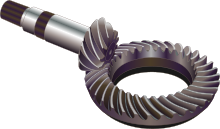Two important concepts in gearing are pitch beval gearbox surface and pitch angle. The pitch surface area of a gear may be the imaginary toothless surface that you would have by averaging out the peaks and valleys of the average person teeth. The pitch surface of an ordinary gear is the shape of a cylinder. The pitch angle of a gear is the angle between your face of the pitch surface and the axis.
The most familiar types of bevel gears have pitch angles of less than 90 degrees and they are cone-shaped. This kind of bevel gear is named external because the gear teeth stage outward. The pitch areas of meshed exterior bevel gears are coaxial with the apparatus shafts; the apexes of the two areas are at the point of intersection of the shaft axes.
Bevel gears which have pitch angles in excess of ninety degrees have teeth that time inward and so are called internal bevel gears.
Bevel gears that have pitch angles of specifically 90 degrees possess teeth that point outward parallel with the axis and resemble the points on a crown. That is why this type of bevel gear is named a crown gear.
Mitre gears are mating bevel gears with the same numbers  of teeth and with axes at right angles.
of teeth and with axes at right angles.
Skew bevel gears are those for which the corresponding crown gear has tooth that are straight and oblique.
